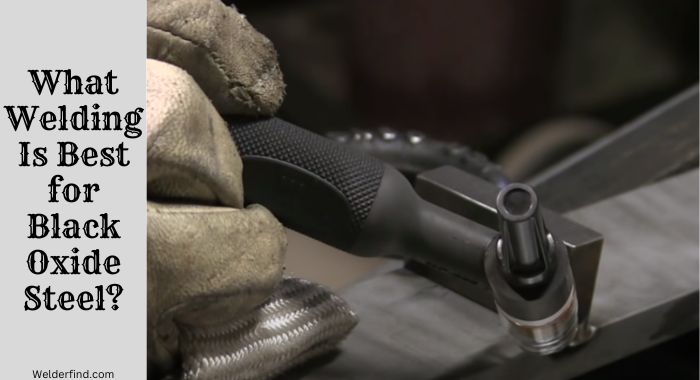The added coating of black oxide plays a significant role in increasing the material’s beauty. Moreover, it assists in withstanding mild corrosion.
But what if steel incorporates black oxide coating, and you want to weld it according to your preferences?
So, it’s common to ask, “can you weld black oxide steel?” Please go through the article to get the real truth of it.
What Is Black Oxide Steel?
For some kinds of ferrous materials like copper, stainless steel, powdered metals, alloys (copper-based), or zinc, the blackening, aka black oxide, works as a transformation coating.
Let it be for reducing light reflection, resisting mild corrosion, or just for appearance, black oxide steel has always been a prime choice among welders.
Can You Weld to Black Oxide Steel?
You can weld through black oxide steel with ease using the right equipment, filler metals, welding gear, and proper steps.
Basically, black oxide is a kind of ultrathin rust that requires relying on oil or wax to ensure qualities regarding corrosion protection.
No need to worry about the welding procedure because welding steel isn’t that difficult. And there is no exception for black oxide steel.
What Welding Is Best for Black Oxide Steel?

You’ll be happy to hear that there are multiple welding processes available in terms of welding black oxide steel, including MIG (Metal Inert Gas), TIG (Tungsten Inert Gas), and MAG (Metal Active Gas).
That said, each will require you to follow a specific guide to perform black oxide steel welding thoroughly.
How to Weld Black Oxide Steel?
As I’ve said earlier, black oxide steel welding isn’t a complex job unless you’re familiar with the right steps.
In fact, it has some similarities with other common steel types in terms of welding. Go through the steps to get a detailed view:
Things Required:
- An Efficient TIG welder
- Shielding gas (if required)
- Electrodes
- Wire brush or such cleaning equipment
- Clamps
- Welding gear (e.g., boots, helmet, gloves, goggles, and welding jacket)
Step-1: Welder Preparation
Here comes the first and most important step. Without collecting the right welding tool and preparing it thoroughly, it’s going to be nothing but a dream to think about steel welding.
Everything requires being well-prepared for the best outcomes, from the electrode to the shielding gas to the amperages.
Depending on the steel thickness, joint size, and polarity, get your hands on the right electrode with the proper diameter.
It’s also necessary to take the right type of tungsten electrode by getting advice from the sellers on which one is ideal for your black oxide steel.
You can set the amp at a maximum rate after starting the welder. After that, it’s okay to turn the rate up or down depending on the thickness and welding conditions.
Regarding the polarity, consider choosing the straight one known as DCEN because it’s less likely to burn the tungsten within each flash.
As for the shielding gas, it’s a must to get the one that ensures optimal flow rates (e.g., 35-50 cubic ft. /hour). Some welders often use helium for enhanced penetration during a steel weld.
Step 2: Material Clean-up
The bitter truth about steel is that it can’t withstand contamination. So, even a wee bit of dust can cause a huge bummer from time to time. As a result, you must get its surface clean using a wire brush.
To eliminate liquid substances like oil, grease, and such things, I’d suggest taking help from a piece of clean cloth.
Step 3: Let’s Begin Welding!
Here begins the real action, where you need to be pretty much attentive to observing each gap of the black oxide steel.
Including that, ensure every piece of material is aligned with what it requires. You may need to use extra filler materials to fill the bigger holes or gaps.
Another point to be noted is that you must hold the TIG gun firmly scoot the arc matches the right spots. Adding extra heat might be required at times, but not too much!
To deal with thicker objects, it’s mandatory to bevel each corner or edge. This is how you can ensure precise operation.
What are 5 Common Mistakes to Avoid When Black Oxide Welding?
5 Common Mistakes:
- Using excessive amounts of heat during a weld.
- Not cleaning up the surface before you start welding.
- Taking assistance from the wrong welding procedure.
- Moving the travel speed too slowly as it causes too much heating during a weld.
- Overlooking the necessity of safety dresses.
How You Can Avoid:
- The coating of black oxide tends to rub off in case you use too much heating. So keeps the temperature at a mediocre level while welding.
- You must clean the surface of the steel using a wire brush because steel is quite unable to tolerate contaminations.
- Avoid using the wrong shielding gas and welding procedure; go with Tungsten Inter Gas welding.
- Just make sure to set the travel speed up during the process; simple as that!
- TIG welding can be quite risky for beginners. So don’t forget to cover your entire body with safety dresses, like gloves, goggles, a helmet, boots, and a safety jacket. If you want beginner friendly welders then go for mig or stick welders.
Last Words
Through the complete write-up of “can you weld black oxide steel,” I’ve shown the most basic way you’re allowed to apply.
Along with the following steps mentioned above, make sure to avoid common mistakes during the process to complete the project successfully.
And yes, there is nothing better than TIG welding black oxide steel; mark my words.
